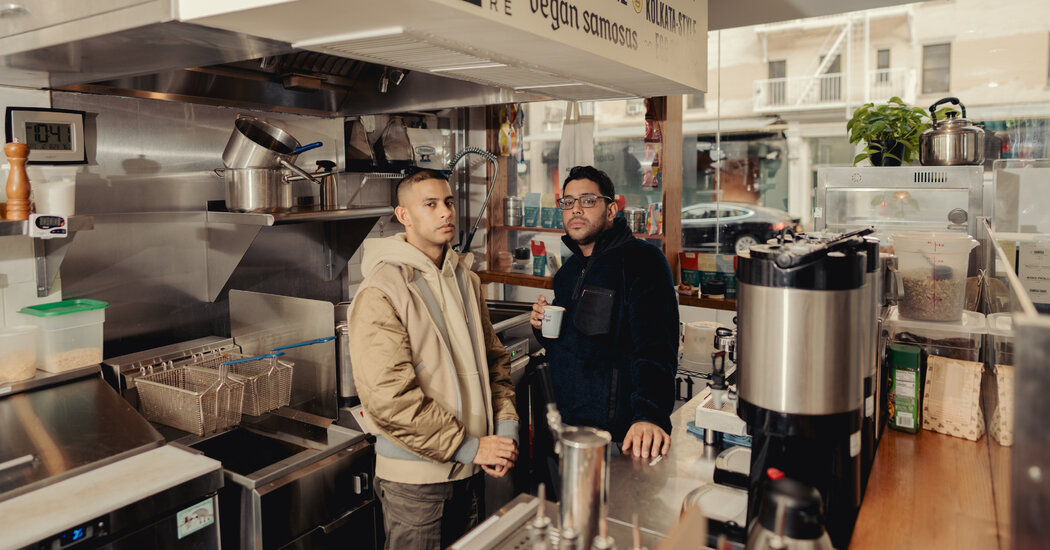Last March, Emily Schildt opened Pop Up Grocer on a Bleecker Street corner in the West Village, selling artfully packaged condiments, beverages and other products made by small, emerging brands in a pay-to-play business model.
Customers can buy artisanal hot sauces or zucchini chips from brands like Peepal People and Van Van that pay a fee to be on the shelves. Typically 150 to 200 brands are on display at a time, and some are replaced on a quarterly basis.
“If we were to be solely reliant on product sales, we would need to sell at a much higher volume,” Ms. Schildt said. “That’s just an impossibility when you’re talking about a store made up of completely unfamiliar goods.”
Rents for retail space in New York continued to rise last year, according to the real estate services firm CBRE, making it harder for independent businesses to survive. One 27-square-foot space in the West Village, an affluent neighborhood in Manhattan, was recently listed for $5,000 a month. But some ambitious entrepreneurs are experimenting with business models, like charging shelf fees or selling wholesale to make ends meet.
“You either have to get creative, or you have to get out of New York,” Ms. Schildt said.
Retail is being reconfigured to address the values of the new customer, said Thomaï Serdari, who teaches marketing at N.Y.U. Stern School of Business. “Innovation is coming from those who, by necessity, have updated their business models,” she said.
But independent retailers face challenges, including high operating costs and finding a model that works.
“Tech evolves, our mobile phones evolve and brick-and-mortars evolve,” said Ani Sanyal, who with his brother, Ayan, founded Kolkata Chai Co., which sells products online as well as at two retail locations in downtown Manhattan.
Their company sells hot chai, Indian street food like samosas, seasonal chai soft serve, along with bags of their chai blends and merchandise. Foot traffic is steady at both locations, Ani Sanyal said, but the company’s e-commerce business accounts for 75 to 80 percent of its revenue.
Kolkata Chai Co. also sells wholesale chai concentrate to Equinox, Juice Press and Boba Guys. The company has collaborated with brands like Transcendence Coffee, teamed up with celebrities like Hasan Minhaj, all of which were posted on its social media feeds.
Using an omnichannel approach — e-commerce, wholesale and in store — the brothers think they can expose a vast array of people to their chai and create lifelong customers. “Since chai is a product that has been bastardized and kind of misrepresented in this country for so long, it was really important for us to be able to have the true experience of our culture,” Ani Sanyal said.
Dolce Brooklyn sells gelato and ice cream from a storefront in the Brooklyn neighborhood Cobble Hill, but it is the company’s wholesale business, selling to high-end restaurants, some with two Michelin stars, that makes a profit. “You need to find different revenue channels,” the company’s owner, Pierre Alexandre, said.
Rachel Krupa’s omnichannel approach for her company, the Goods Mart, includes curating and distributing snacks at hotels, coffee shops and corporate pantries. At her minimalist shop in SoHo, one of three locations, she sells packaged snacks from 200 brands, mostly emerging producers, like garlic chili crisps made by Mama Teav’s, a company in Oakland, Calif.
The Goods Mart was one of Mama Teav’s first accounts when it started two years ago, and today Mama Teav’s products are stocked in 420 stores across the United States. “As a small maker, a new brand, we’re not going to get into Whole Foods right off the bat,” said Christina Teav-Liu, a founder of Mama Teav’s.
Ms. Krupa said she would not be able to give exposure to brands like Mama Teav’s if she had landlords who were simply trying to make money. Her first landlord, Bret Trenkmann, saw value in her mission and gave her a fair rent in SoHo, as did another landlord, Tishman Speyer, on her second location at Rockefeller Center.
Consumers, especially tourists, want authentic experiences that they cannot get at home, said Ms. Krupa, who also runs a public relations firm, Krupa Consulting, that works with packaged foods and wellness brands. “You’re not going say, ‘Oh, my gosh, I went ice skating at Rock Center — and I ate at Chili’s,’” she said.
Landlords play a major role in the growth and survival of independently owned businesses, said Stacy Mitchell, a co-executive director of the Institute for Local Self-Reliance, a nonprofit advocate for independent businesses. National chains might be a safer financial choice compared with an independent entrepreneur, but leasing to them is shortsighted, Ms. Mitchell said.
And giving small-business owners a break can be good for landlords. “The quality of the businesses at the street level affects the rents that they’re able to get for the upper floors, whether those are offices or housing,” she said.
The United States is undergoing a cultural shift in retail buying, said Syama Bunten, the founder of Scaling Retail, a consultancy in San Francisco. The direct-to-consumer model, pioneered by companies like Dollar Shave Club and Stitch Fix, was an innovative approach years ago but now is saturated.
The new phase of shopping falls into two main categories: cheap and easy on Amazon and with a feeling of connection inside brick-and-mortars.
Another way for independent owners to build business is through connection and community, often through in-store events, which creates vibrant street life, foot traffic and a gathering of like-minded people. A bus shelter ad might get a brand visibility, Ms. Bunten said, but creating events and spaces for customers creates a much stronger emotional connection.
“It may not be that 100 percent of visitors turn into customers,” she said, “but you have 100 percent chance of your brand having a much more lasting effect in someone’s mind than a traditional advertising piece.”
Despite finding levels of success, some small retailers wonder if it is worth the effort. Many of them have sunk their life savings into their businesses and raised additional funds through institutional and angel investors, not to mention friends and family. They operate sustainable business models and post constantly on social media. Yet the cost of leasing and creating a space remains a barrier.
“Something needs to change,” said Ms. Schildt of Pop Up Grocer, who spent 18 months searching for the right storefront.
If city officials and landlords do not realize there are prohibitive costs around rent for independent retailers, “the city is going to lose its color,” said Ani Sanyal of Kolkata Chai Co. “It’s going to lose the things that make people want to come to New York.”



